As the weeks leading up to the prerelease unfold, Zendikar is proving to be one of the most exciting and heavily anticipated sets in the game’s history. I have been talking about Zendikar a lot these past few weeks, and this week will be no exception. This set is going to be unreal in many regards, pushing the envelope in a few ways that I am not yet sure how to digest. For instance, it seems like absurdly good value to open these packs, but at what cost? Even if the people who speculate and buy a lot of Zendikar make loot, and even if tons have to be opened so that everyone has their fetchlands, etc, where is it coming from?
At some point, there would seem to be a limit. I mean, you and I might make several dollars cashing in on Zendikar, but who is paying for it? You might answer that everyone that plays Magic might be splitting the bill, and you might be right, but this money doesn’t grow on trees. Even if everyone that buys all this Zendikar is happy with the new cards (which they probably will be), there is a subtle tension, as all these new Zendikar cards that are being played with will tend to devalue some other cards or stunt the growth in value of other cards, unless more people end up playing Magic.
As such, I guess I am starting to theorize that it is not power creep, so much as it is cash depletion that we need to be mindful of. I am not saying that Zendikar will break the bank, but it does seem like the system needs more people playing to support the kind of growth that is apparently taking place with regards to printing a quantity of new and exciting cards.
From my perspective, the value of the cards is largely tied to the utility of having them available to play. There are only so many Magic players in the world at the moment. Combined, they still only play a finite amount of Magic. Neglecting for a moment the utility of cards for collective purposes (which is very meaningful, but also very finite) we have a theoretical upper limit to how much Magic is going on in total. Arid Mesa; Warren Instigator; Mindbreak Trap; Bloodghast; Iona, Shield of Emeria; Day of Judgment and so on may all be great cards and get played a lot, but at the end of the day, there is only so much Magic being played in total. If the amount of Magic played on Earth does not increase, then tons of new cards being played will result in more old cards being played less.
Of course, this has been going on the whole time, and Standard is the perfect example of this, but what I am suggesting is that the absurd sales of M10 and surely even greater sales of Zendikar are causing there to be more and more Magic cards in the world that are not being played. This is hardly an ominous observation, and it is far from radical. All I am saying is that there are becoming more and more financial incentives for players to help increase the player base in Magic, aside from the obvious “It’s nice to have more people to play with.”
Think of it like Poker. A lot of people play Poker for fun. They gamble, sure, but they are not relying on Poker making them a lot of money in order to play. They want to win and they may have good chances, but there is more to it than just making money. There are also, however, a large section of the community that profits from playing Poker, and this profit is an important motivator for them to enrich the Poker culture. I mean, obviously you would not have stars like Ivey or Williams or Helmuth if you didn’t have the potential for large profits, as they would just do something else; however, you also wouldn’t have the thousands of strong Poker players across the globe essentially “giving poker lessons,” paid for by the money they win against weaker players who want to learn how to be better at Poker and who want to be entertained.
Now imagine the world of Poker if there weren’t new players added to the mix, or even an increase in the actual size of the field. Without an increased player base, it becomes harder and harder to consistently profit at Poker, and the rewards are diminished. This is not the end of the world, but it does take away from one of the principal motivating factors behind the culture.
On the other hand, every time there is a surge in new Poker players, the existing community is better off. It is not just that it is “easy money,” though often it is. It is that there are a lot of people who want to know more about something that other people already know. Part of why these people want this skill in Poker, however, is the promise that, later, there will be more new people who will not yet be good, so that this generation of player can have someone to “teach.”
Poker players are not (generally) victimizing the new players, hustling them out of their money through foul play. Rather, they are providing a service to them (Poker lessons, in effect, as well as entertainment). Magic is actually very comparable.
It is not just the Pros that want more people to play Magic (more players = more prize money, more Pro Tours, etc), but it’s also the people that already play. Let’s say for the sake of argument that there are 6 million regularly active Magic players. Now imagine for a moment that 3 million more people began playing. You can see that while the top 0.001% now have 50% more people that they are more skilled than and have something to offer, it is also reasonable to say that someone that earlier was at the 50 percentile, has essentially moved up to the 67 percentile.
Obviously, these numbers are out of thin air, but the point is that even the guy in the middle increases a huge surge in the number of players over which they have more experience. This is much more practically applicable than just winning more at FNM. This also means that these people are now in a much more advantaged position with regards to harnessing Magic culture, which shows through in so many ways beyond just winning a local tournament.
For example:
– Profit while trading cards with new players.
– Profit from having larger events locally and more people to play.
– More people playing means more of the cards printed are actually physically getting played. As such, more of their value is realized, making them actually worth that $5, $10, or $20 price tag.
– If there are twice as many people in your area, that means that each person has to, on average, open half as many packs in order to get the same amount of fetchlands, Day of Judgments, Warren Instigators, Mindbreak Traps, and so on. There are twice as many people splitting these cards, sure, but the increase in new players means a lot more people who “don’t need 20 fetchlands, Mindbreak Trap, etc.” Not every card is for everyone. If you want all the cards yourself, it benefits you if there are more people that don’t actually need every card.
The advantages continue further than many people realize, in several directions. Anyway, I am trying to avoid a decent into the beauty of capitalism, so let’s get to some previews!
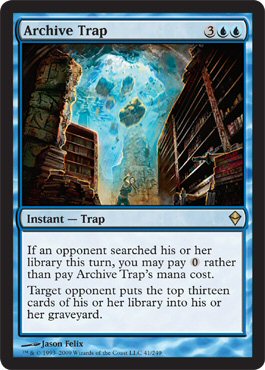
Check out the latest sick Trap card to be unveiled by our friends over at MTGSalvation.com. I wonder if there will be sweet zero-mana traps in other colors besides Blue?
First, you are not the first person to imagine being on the draw against someone and they fetch up a land on turn 1, at which point you promptly mill them for the exact 52 with your 4 Archive Traps.
Second, this card is obviously good in some sort of a dedicated mill strategy, but it has plenty of applications beyond that. For instance, if you are playing a format with top deck tutors, this card is a zero-mana answer, albeit a risky one.
Third, this card has cute synergy with cards like Path to Exile. The first time someone doesn’t search from your Path to Exile for fear that you will mill them out, it will all be worth it.
I am not sure how you best abuse this card, but it is a potentially exciting card because it does create a pretty big effect for zero mana. I am thrilled that it cannot target yourself, or it would be totally obnoxious in Extended Dredge decks. It is not really the type of card you just throw into a deck wantonly, but the card has potential.
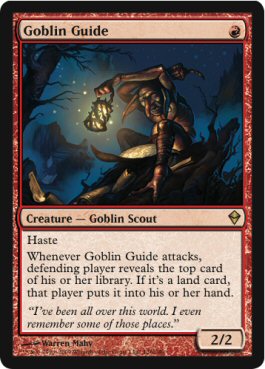
The next card for your consideration is the wildly controversial Goblin Guide. This is one of those cards that some people say is totally insane, and others say you would have to be insane to use it. Comically, I think he is actually much more of a middle of the road type card than either camp would have you believe.
How do you evaluate a card like this? I mean, say what you will about power creep, but a 2/2 haste guy for R is off the charts. How much does his drawback really hurt you?
There is no question that there is a part of me that feels physically pained every time I Path to Exile a creature (must get card advantage!), and this card invokes a bit of that. Still, I like Plowing creatures for only one mana, and I like 2/2 Haste for R. When trying to examine the drawback, I tried thinking about it from a few different angles. For instance, it is sort of like he gives your opponent 40% of a card each time he attacks, right? Although, the funny thing is, when you attack with 2, this percentage goes down, since if the first one gives them a land, the second one is only 40% to give them another, whereas if the first misses, the second one is 100% to miss.
Add to this the fact that the information you are gaining is of non-zero value. I mean, what if you see that they have a Day of Judgment on top of their library. Fetchlands are good against him, no question, but I think he will prove to be a good tournament card. He looks like he is all brute force, but he is really a thinking man’s card. Sometimes, it is right to suck it up and not attack with the Goblin Guide. If it isn’t going to change your clock, why give them an extra look for their sweeper?
This card is not going to push Goblins over the top to a tournament-dominating archetype, but they will be competitive and he will see plenty of play outside of Goblin decks. He is certainly not going to have the impact on Standard that Figure of Destiny did – nowhere near it, in fact – but he will be decent and should have crossover to other formats.
Although I respect his power, I also look forward to the countless games I gain an advantage on the defensive as I anticipate this being one of the most misused cards in the set. If you are thinking that you just want to throw this guy into your deck, you are probably wrong. If you thinking you can reliably kill an opponent before the advantage they are gaining and their own game plan kills you, you might be on to something. I have found that it is often easier to see the effect Goblin Guide has when defending. Ask your playtest partner to watch carefully and try to determine how often they win a game as a result of the advantage they gained from your Goblin Guide. It is often tough to track, but if you are perceptive, you should get a good feel for how much of a price is being paid.
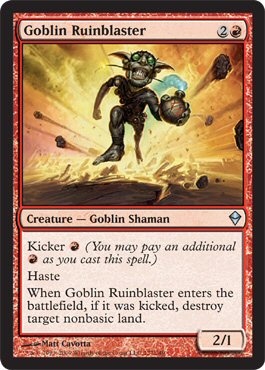
While we are on the topic of Goblins, let me show you another one for which I am very excited, although is interestingly almost completely opposed to Goblin Guide.
Goblin Ruinblaster obviously doesn’t work well at all with Goblin Guide, but it’s very good in its own right. You just have to decide which way you are going. Do you care about their mana or don’t you? If you don’t, Goblin Guide has potential. If you do, Goblin Ruinblaster is your man.
Avalanche Rider saw tons of play in many formats. as is essentially the same card, but with echo. The primary differences beyond the echo are:
1. Avalanche Rider has an extra point of toughness, but worse creature type.
2. Goblin Ruinblaster can be played as a three drop haste creature, in a pinch.
3. Avalanche Riders can hit basics, which matters more depending on the format.
4. Goblin Ruinblaster doesn’t work as well with reanimation type effects.
5. Goblin Ruinblaster is double Red, but works with Bloodbraid Elf (you CAN kick off of Cascade).
Although, in my opinion, these may all pale in comparison to the lack of echo, which makes Goblin Ruinblaster much better at securing modest value. Interestingly, another Goblin with the potential to see more play outside of Goblins than in it. I will tell you one thing for sure, as a Five Color Player, I would not want to play against this card. There are SO many cards capable of securing modest value, the push towards midrange continues!
It is interesting to consider all of the implications of cards like this and Gatekeeper of Malakir (a.k.a. The Edict Guy), such as playing a land before you Bloodbraid Elf, in case you flip one of your Kickers. There is a strange tension building in Standard between cards like Baneslayer Angel and Cruel Ultimatum which demand one-for-one answers like Doom Blade, Thoughtseize, Remove Soul/Negate, and so on, or else you are severely punished; versus cards like Bloodbraid Elf, Blightning, Gatekeeper of Malakir, Anathemancer, Bituminous Blast, Goblin Ruinblaster, Broodmate Dragon, and Esper Charm, which build tricky, modest, efficient advantages.
Whereas Baneslayer and Cruel Ultimatum type cards will win the game if you don’t have the right answer, the answers from which you are to choose are generally poor against the two-for-ones listed after. While each individual two-for-one you let your opponent have may not kill you, the sum total is hideously difficult to overcome with a deck full of one-for ones. While there are fewer cards that demand immediate one-for-ones, like Baneslayer Angel, the problem is that if you do not have the answer for the bomb cards, you will lose the game in no time flat. You can get two-for-oned a lot and still be in the game, but a single Cruel Ultimatum is usually curtains.
Why not play all Baneslayers and Cruels, etc? That might be the right strategy, but the problem is that a clever two-for-one player can anticipate which bombs you are playing and set it up so that their stream of two-for-ones beats you, while all they have to do is make sure they don’t lose to your big cards.
Why not play all two-for-ones? Because if you don’t get value out of both parts of the two-for-one, they are generally inefficient, so you actually lose value, meaning choosing poorly can be very costly. Also, generally, if you face someone who is “a little bigger” you will be at a disadvantage. If you try to be the “biggest,” you will be at a disadvantage to the “fastest.”
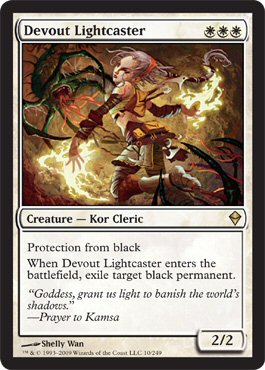
Here is an excellent example of a two-for-one that could be great or could be a common deck-building trap. Devout Lightcaster is obviously a two-for-one waiting to happen, with both halves being awesome… against a Black deck.
The question is, how good is he against a random opponent? First of all, you need to have a good grasp of the metagame to determine if he is more of a Pearled Unicorn or more of a Paladin En-Vec that also Vindicates when he comes into play.
This card seems like a great way to gain an advantage against a field of Putrid Leeches, Bituminous Blasts, Doom Blades, Anathemancers, Sorin Markovs, but looks real awkward real fast if you make the wrong call and the field is all Baneslayers and Cruel Ultimatums.
Gatekeeper of Malakir may totally trump Baneslayer, but he looks really silly against someone that just wants to Cruel you, and conversely, Countersqualling the Cruel is sweet, but if they drop Baneslayer you will be sorry.
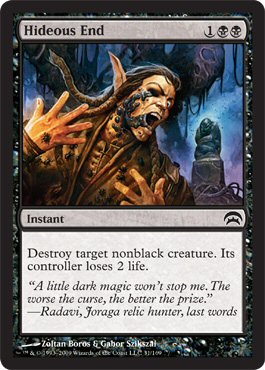
There is certainly a middle ground, of course, such as Hideous End, which is very nearly a one-for-one. Like Countersquall, it provides a little value, a small bonus to pay you for correctly anticipating the field.
Long ago, there were relatively few good options for a variety of cards, such as Lightning Bolt, Sword to Plowshares, Control Magic, Incinerate, and Paralyze being the best removal spells, and Hypnotic Specter, Erhnam Djinn, Pump Knights, Serra Angel, Autumn Willow, and so on.
Now there is such a variety of options that if you can correctly anticipate what everyone else is doing, you stand to gain a noticeable advantage. For instance, you think your opponent will play Baneslayer Angel? Play Doom Blade. Think they will play Doom Blade? Play Broodmate Dragon. Think they will play Broodmate Dragon? Play Bituminous Blast. Think they will play Bituminous Blast? Play Baneslayer Angel. See what I mean?
It is not just about your finishers. The key is that it is not nearly so important what people played last week (anyone can figure that out), but rather what people will play next week. Part of the reason I made the controversial decision to play Broodmates when most others played Baneslayers was that since everyone else played Baneslayers, the people who had decks that were good against Baneslayer rose to the top. The people with edge over Broodmates had to deal with Baneslayer much more often, helping keep them down. As such, as the tournaments progressed, the field would actually get better for me. You might think Baneslayer would make it easier to make Top 8 with, but I am more interested in what gives me a better show of winning the whole thing, a common theme in many of the decks I try to build.
I am not suggesting that Broodmate or Baneslayer is better or worse in the format to come, nor that I am actually always accomplishing my objectives of maximizing my chances of winning each tournament, but I am trying the best I can. I have won plenty of tournaments in my day, but have yet to win a Pro Tour, so obviously there is a lot of room for improvement in my execution.
I think as a general rule, every time a good one-for-one creature is printed (Putrid Leech, Baneslayer, Tarmogoyf, Boggart Ram-Gang, Ashenmoor Gouger, Sphinx of the Steel Wind, Kird Ape, Juzam Djinn, etc) every other good one-for-one creature gets somewhat worse, since people are that much more willing to play spot removal.
On the flip side, every “value creature” that is printed (Bloodbraid Elf, Gatekeeper of Malakir, Goblin Ruinblaster, Sprouting Thrinax, Flametongue Kavu, Kitchen Finks, Anathemancer, Silvergil Adept, Glen Elendra Archmage, etc) actually makes the one-for-one devastating cards that much better, assuming you pick the right one. Even though Gatekeeper of Malakir may kill Baneslayer Angel, if enough people play cards like Gatekeeper of Malakir and other two for ones, less people will want to play Doom Blade type cards. We are not just talking cutting Doom Blades for Gatekeepers.
Whenever one is playing Gatekeepers, Bloodbraids, Broodmates, and so on, you don’t want to be the guy holding Doom Blade, you want to cast Cruel Ultimatum. When cards like Doom Blade drop in popularity, Baneslayer rises, as we saw last season when Bloodbraid Elf and Five Color Control ensured that every creature that was making an impact was a two for one… making it a great time to Baneslayer (for at least a couple weeks).
See, properly metagaming is a very nuanced art. You don’t want to just play what is good against what people are doing, you want to play what is good against the logical extension of the strategies people know about. For instance, in Shards Block, we realized that Bloodbraid Elf into removal was so good at beating one-for-one creatures (well, all non-land permanents), that we vowed not to play non-land permanents unless they “beat” Bloodbraid into Maelstrom Pulse, such as Bloodbraid, Kathari Remnant, Ajani Vengeant, Nicol Bolas, and Wall of Denial.
What will the new Standard be like? Volatile, most likely, shifting rapidly week to week, as cards like Cruel Ultimatum and Baneslayer move in and out of favor. They will always be strong, but sometimes they will be better positioned than others. It would appear at first that the best cards in the format by far are Bloodbraid Elf and Cruel Ultimatum, so that is where I think the game begins.
Bloodbraid Elf is the defining two-for-one and Cruel Ultimatum is the defining “big card.” They are far from the only cards you can build around, but the game is going to be starting with them and figuring out how to use them. Then figure that everyone else is doing the same, and figure out how to beat that. Then figure that some percentage of those people will go a step further and figure out how to beat the deck that beats the deck. A smaller percentage still will take it another level, and so on. The real game is figuring out how many levels to take it.
It is like playing Rock-Paper-Scissors when Rock beats Scissors 70%, Scissors beats Paper 60%, and Paper beats Rock 60%. What do you play? Of course the first level of strategy is to play Rock, since it has the “best percentages.” This makes Paper an appealing choice, no? Of course you wouldn’t be the only one to think of this, making Scissors a deceptively good choice…
The point is, Bloodbraid Elf and Cruel Ultimatum are the strongest cards in the abstract, but since everyone knows this at this point, you are going to need to rely on more than just raw card power. The most successful players will be the ones that know when to adjust their strategies another level in technology to beat the field.
Another couple of cards I like that I hear a lot of people bash are:
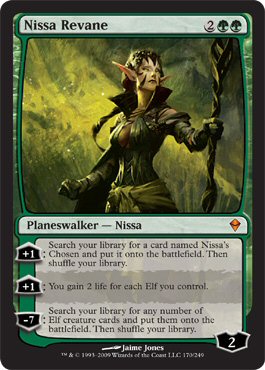
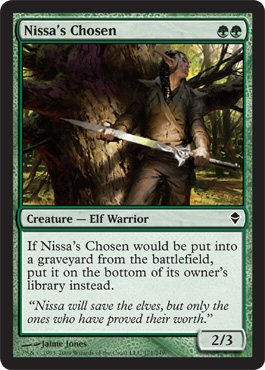
These two have received a lot of flak because of people focusing on negative ways to spin them, such as being hypnotized by Nissa Revane’s vulnerability to Lightning Bolt or Nissa’s Chosen being essentially an Elvish Warrior reprint. I think that there is a deceptive amount of strength possible with these two.
First, Nissa’s Chosen may be a glorified Elvish Warrior, but I have come so close to playing Elvish Warrior many times and it would not take much to get me on board.
Second, Nissa Revane actually exerts a tremendous pressure on the board, if unchecked for even a moment. Elspeth has proven a tournament powerhouse, and she commits only a 1/1 to the board each turn. Nissa’s 2/3’s are much more powerful and are actually generally worth more than a card, each turn, making the impact stronger than Jace (albeit in a different way).
Obviously, Elspeth’s second ability is where the real money is at, whereas Nissa’s second ability is not particularly strong in tournament play, but it is a nice option and at least when it is good, it is VERY good. I mean, it is very realistic to think that against a Red deck you will be able to play Nissa, gain 6 or 8 life and have a 3 toughness Planeswalker that MUST be dealt with immediately. I understand the vulnerability to sweepers like Fallout, but look at the creatures she gets…
Finally, we get to her Ultimate. Every Elf in your deck? It is not hard to imagine that being game over, if only on account of the Bloodbraid Elves and Nissa’s Chosens, let alone if you play things like Elvish Archdruids.
Will she die a lot? Absolutely, no question. Having 3 Loyalty is a precarious amount by any definition, but just as Bloodbraid Elf dies to Lightning Bolt, so does Nissa. It is just that she always flips up a Nissa’s Chosen. I know that is not an exciting Bloodbraid flip, but it is not the worst, and she does it again next turn. If you do it once, you are often getting paid enough value to have it be worth it. If you ever get to keep her in play for a turn, she scales out of control quickly. First with creating a board presence, then with her killer Ultimate. It won’t reshape the game, but this card is actually pretty sweet, especially considering the shortage of good two drops we seem to find more and more.
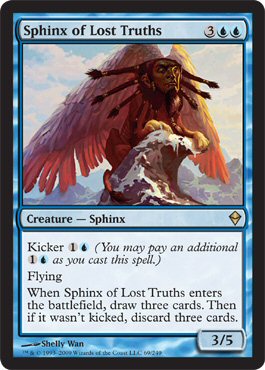
One last card I want to cover today is the Sphinx of Lost Truths. This guy is cool on a variety of levels, and some are somewhat nonintuitive.
First, I am a man that loves value, and this guy has that going for him. A 3/5 Flier that lets you Ancestral Recall? Sweet!
Next, I love options… and this guy has them. He is a guy, he can draw cards. You might kick him for value or you might filter away the chaff. You might want to reanimate him in a Dredge deck, you might want to play him as a kill card in a Control deck. There are a lot of interesting possibilities to him.
Seven mana is an awful lot to pay for a guy, but the key is that he is definitely not seven mana. He is a five-drop that filters even without the kicker. The kicker is just a nice bonus that should the game go long, you can keep some extra cards. I think he is perfectly reasonable even without the Kicker, so I am intrigued.
The problem I have with this card is that at the five spot, it competes with Baneslayer. At the seven spot, it competes with Cruel Ultimatum. Those are not the kind of comparisons that are going to make it look good. As such, the Sphinx of Lost Truths is probably going to be poorly positioned in Standard, though he might be powerful enough that he finds a home, though I wouldn’t bet the farm on it.
Okay, I’ve gotta roll out for this week, though I am clicking back over to MTGSalvation regularly, looking for what else this set has in store for us. It seems totally crazy and it’s an exciting time to be playing, but I can’t stress enough that if are in a position to, this is probably one of the best times ever to buy boxes or cases. Be smart about your resources and invest wisely, as you are the one responsible for how you spend your money. I am just saying that I am personally investing in some Zendikar, as this set seems unparallel in terms of how well it will open in terms of dollars.
I am pumped to be flying down to Atlanta for the Zendikar prerelease in a few weeks. Make sure if you are in the area that you stop over and see me. It should be a ton of fun.
See you guys next week!
Patrick Chapin
“The Innovator”
PS: Bonus Decklist!
Not A Punk Red Deck
Patrick Chapin
4 Warren Instigator
4 Viashino Slaughtermaster
4 Inner-Flame Acolyte
4 Simian Spirit Guide
4 Greater Gargadon
4 Rite of Flame
4 Blazing Shoal
4 Fury of the Horde
4 Boros Swiftblade
4 Colossal Might
4 Gemstone Mine
4 Arid Mesa
2 Unstable Geyser
2 Stomping Ground
2 Sacred Foundry
1 Blood Crypt
1 Mountain
This one is more fun than tournament-playable, as it is too inconsistent and easily disrupted, but it is fun and gets more turn 1 kills than you might think, with turn 2 kills regularly. I am interested if any enterprising deck builders can find a way to actually step this deck’s game up… it is a long shot, but it is definitely a cool deck with which to playtest.

